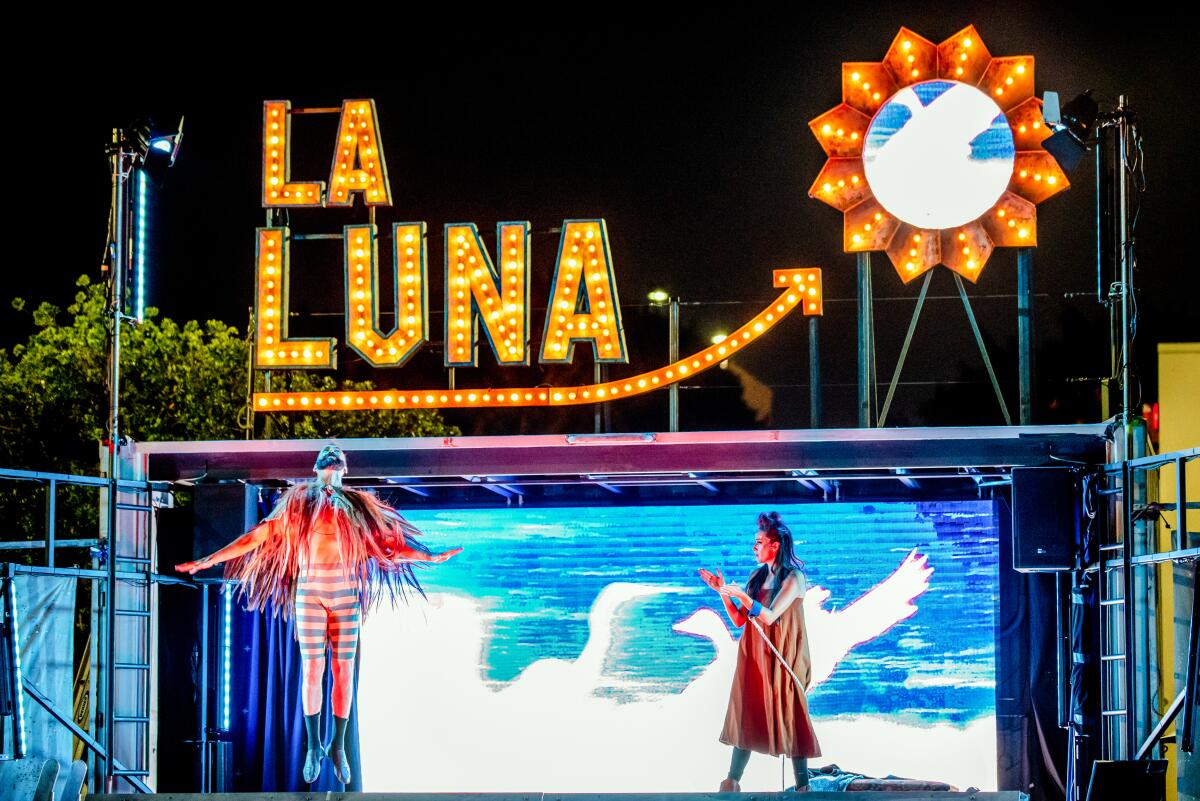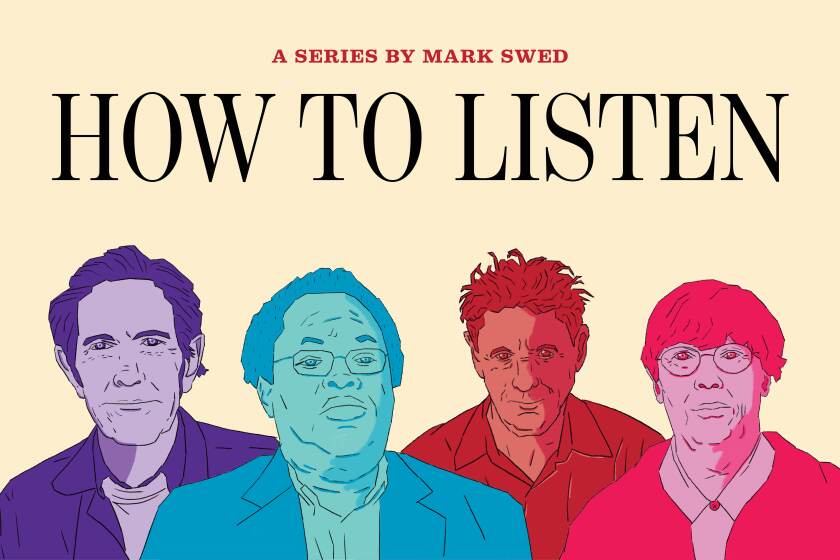Review: Opera in a Santa Monica shipping container? ‘Birds in the Moon’ makes it magical

The carny rolled into Santa Monica on Wednesday. OK, not exactly a carny, this modern shipping container hauled by a semi truck down the 5 from Berkeley to a parking lot across the street from the old Santa Monica Post Office. Its cargo, a state-of-the-art audio and video stage set. Its mission, opera.
We’ve obviously come a long, long way, you might imagine, from a brutish Anthony Quinn on his motorcycle pulling a ramshackle portable theater in Fellini’s “La Strada,” along with the enigmatic, doe-eyed Giulietta Masina, their discomfiting relationship puzzling and riveting cineastes since 1954. Even so, the roots of “La Strada,” which gave new meaning to the concept of road show, along with an unforgettable Nino Rota score, haunt Mark Grey’s new discomfiting and riveting two-person opera.
The West Coast premiere of “Birds in the Moon,” with performances through Saturday, marks the return of the Broad Stage to live shows after 18 months (if you don’t count watching something from your car, and I don’t). The remarkable undertaking marks more than that, however. “Birds” is very sophisticated artistically and technically. A road show plopped down on Lot No. 27, ambulances and motorcycles driving by, is a quite different than opera at La Scala.
Vaxxed and masked, we sat on folding chairs. A chill wind blew. The sun set, an orange sky adding to the magic of the illuminated set. Passers-by on the sidewalk looked on from afar quizzically as we listened and watched, maybe just as quizzically, because there is no easy way to say exactly what “Birds in the Moon” is.
Grey, himself, is a one-off. Though a composer, he entered the music business as a sound engineer, primarily creating amplification for Kronos Quartet concerts and for John Adams’ operas. The sound mix wound up being a revelatory and revolutionary part of the artistic mix by relying on weird science, which is to say his ears above the machine.
He still does that for select projects, but his larger aim has become to create his own wide range of compositions, most notably music theater that revolves around weird science. The most recent and ambitious is his 2019 opera “Frankenstein.” Grey and librettist Júlia Canosa i Serra used the considerable technological and musical resources of La Monnaie opera house in Brussels to take a broad look at a machine-made man, imagined in the past and troublingly carrying us into the future, our humanity and environment on the line.
At the opposite end of the spectrum, Grey and Canosa i Serra have now proposed their opera caravan, a 70-minute work for an actor, a singer and a string quartet. And, of course, electronics. For this, they have followed Mary Shelley with another eccentric fantasist of yore, Charles Morton. The 17th century scientist came up with the idea that birds migrate to the moon where they reproduce, bringing their offspring back to Earth.
Coronavirus may have silenced our symphony halls, taking away the essential communal experience of the concert as we know it, but The Times invites you to join us on a different kind of shared journey: a new series on listening.
Soprano Maria Elena Altany is the Bird Mother, innocent, enigmatic, ever so slightly Masina-like. She stands in opposition to brutish, athletic and also enigmatic Austin Spangler, the Ringmaster who has his own moon wishes. A battle of wits, of wiles, of domination, of ideals and of means of expression ensues.
The concept is straightforward, Canosa i Serra’s poetic texts less so. But there is more than narrative to hold our attention. The container becomes, in Chad Owens’ stage design, a two-story carnival-esque, Fellini-esque stage. Deborah O’Grady’s video backdrop trips light (and moon) imagery fantastically. Elkhanah Pulitzer’s staging makes vivid the complex relationship of singer and actor, of flight and resistance, of dreams of migration and the reality of the migrant.
Music, though, is what matters, and Grey’s operates with dazzling variety. His electronics create mood and change an urban environment we cannot ignore into an un-urban one before our ears. And back again with, say, a mischievous hint of Rota to remind us that this is a show.
A string quartet and electronic music offer one kind of dialogue between machine and humanity. The characters, another. Spangler is hawker, Altany is subdued bird who soars in song, her power revealed in her voice. Her words can be unintelligible, but isn’t a bird’s flight also, to us, unintelligible? The way we experience her flight is through identifying her splendid need for it.
The task of such opera is daunting not only in pitting theatrical obscurity against immediacy but also in the sheer physical challenges of the project. In my case, I followed what was going on without actually knowing what that was, as the ever-contradictory multimedia worked its wonders and worked against wonder at the same time.
The Meyer Sound system is imaginative. Two smaller speakers and a pair of subwoofers create an effect that is not artificially immersive but more than stereo and fulfilling. Balance is delicate and never sure outdoors. I sat up front, and it was too loud. I’m told it was too soft in the back.
Although the stage can be set up in four hours if necessary, real world conditions with an audience are required to make the final adjustments, and Grey was not on hand, having been seduced to Detroit to work on a project with Yuval Sharon at Michigan Opera Theatre. Still, this is said to be solvable for the rest of the performances.
How we solve our crises with migration — political and ecological — is the far bigger and more troubling issue on which the opera ends. That is Grey and Canosa i Serra’s main metaphor, and they have impressively put their money where their operatic mouths are, facing whatever obstacles they must while schlepping the whole shebang from place to place.
‘Birds in the Moon’
Where: Parking Lot No. 27, corner of Arizona Avenue and 5th Street, downtown Santa Monica
When: 7 p.m. Thursday, Friday and Saturday
Tickets: $25-$75
Info: thebroadstage.org
More to Read
The biggest entertainment stories
Get our big stories about Hollywood, film, television, music, arts, culture and more right in your inbox as soon as they publish.
You may occasionally receive promotional content from the Los Angeles Times.












